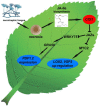Jasmonic Acid as a Mediator in Plant Response to Necrotrophic Fungi
- PMID: 37048100
- PMCID: PMC10093439
- DOI: 10.3390/cells12071027
Jasmonic Acid as a Mediator in Plant Response to Necrotrophic Fungi
Abstract
Jasmonic acid (JA) and its derivatives, all named jasmonates, are the simplest phytohormones which regulate multifarious plant physiological processes including development, growth and defense responses to various abiotic and biotic stress factors. Moreover, jasmonate plays an important mediator's role during plant interactions with necrotrophic oomycetes and fungi. Over the last 20 years of research on physiology and genetics of plant JA-dependent responses to pathogens and herbivorous insects, beginning from the discovery of the JA co-receptor CORONATINE INSENSITIVE1 (COI1), research has speeded up in gathering new knowledge on the complexity of plant innate immunity signaling. It has been observed that biosynthesis and accumulation of jasmonates are induced specifically in plants resistant to necrotrophic fungi (and also hemibiotrophs) such as mostly investigated model ones, i.e., Botrytis cinerea, Alternaria brassicicola or Sclerotinia sclerotiorum. However, it has to be emphasized that the activation of JA-dependent responses takes place also during susceptible interactions of plants with necrotrophic fungi. Nevertheless, many steps of JA function and signaling in plant resistance and susceptibility to necrotrophs still remain obscure. The purpose of this review is to highlight and summarize the main findings on selected steps of JA biosynthesis, perception and regulation in the context of plant defense responses to necrotrophic fungal pathogens.
Keywords: COI1; circadian clock; defense responses; jasmonates; necrotrophic fungi; resistance; signaling.
Conflict of interest statement
The authors declare no conflict of interest. The funders had no role in the design of the study, in the writing of the manuscript or in the decision to publish it.
Figures


References
-
- Zhai Q., Yan C., Li L., Xie D., Li C. Jasmonates. In: Li J., Li C., Smith S.M., editors. Hormone Metabolism and Signaling in Plants. Elsevier Ltd.; Amsterdam, The Netherlands: 2017. pp. 243–272. - DOI
Publication types
MeSH terms
Substances
LinkOut - more resources
Full Text Sources

